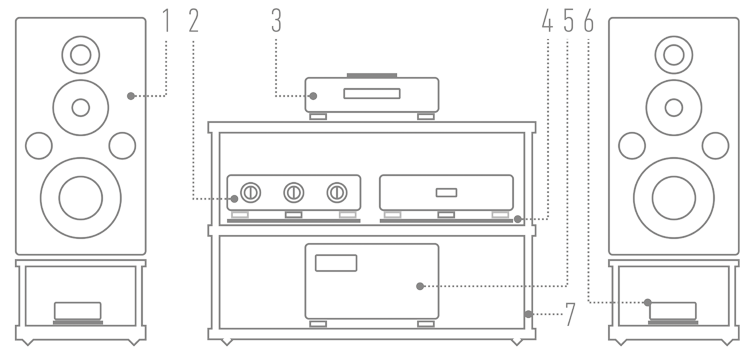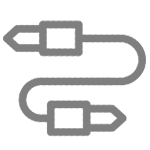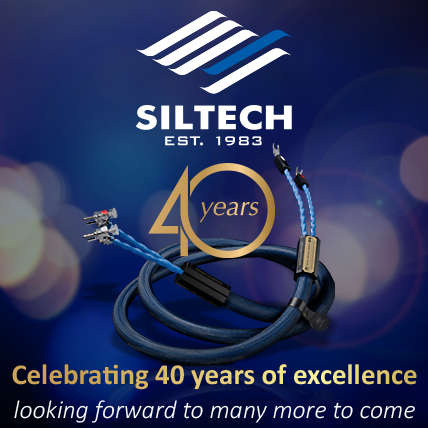|
ANALOG INTERCONNECT RCA Next Level Tech
Manufacturer: NEXT LEVEL TECH |

|
Review
text WOJCIECH PACUŁA |

|
No 249 February 1, 2025 |
|
˻ PREMIERE ˼
MR. ROBERT SLOWINSKI’S COMPANY NEXT LEVEL TECH (NxLT) of has been developing unhurriedly and steadily. Every now and then, but not too often, new products are ready. We started our adventure with it shortly after its debut, in March 2021, with the Water RCA analog interconnect. We liked it. There was everything in its sound that could be expected from a good product in this price range. And something more - some intrinsic attention to detail, both in how it conveys the signal and how it's made, as well as in the packaging, more → HERE. 
This stability is evidenced by the gradual expansion of the range to include the higher-end Flame series, which we have had the opportunity to review with as many as three models: an RCA analog interconnect, a speaker cable and a LAN; the former received a RED FINGERPRINT award from us, more → HERE ˻ PL ˺. With the latest product, another RCA interconnect, we cross another threshold with Next Level Tech. We thus begin testing the latest Ether series. When asked about the origins of its name, Mr. Slowinski replied:
CABLES FROM THE NxLT SERIES we tested were constructed differently. The biggest differences were in terms of the conductor used in them. As their designer said, when testing the Water interconnect, the model for him was the Hijiri XLR Million interconnect. After two years of searching, he came across a conductor that had, in his opinion, a real potential. It was an almost 20-year-old, soft, tinned oxygen-free copper with an uncommon dark coloration. The higher Flame series is based on a different conductor. In its case, it's a proprietary combination of braided silver solid core conductor with OFC copper. In the Ether series, Mr. Slowinski took yet another route. In it, the conductor is cold-pulled so-called red OFC (Oxygen-Free Copper), custom-made for Next Level Tech from scratch. The red copper owes its name to its purple-red color. In general, it is simply pure copper, but this is not an accurate description of it. Strictly speaking, pure copper should theoretically have a content of this metal close to 100%. And red copper contains oxygen and is also known as oxygen copper. The Cu content of red copper ranges from 99.5% to 99.99%. It has good electrical and thermal conductivity, excellent ductility and is easy to heat and pressure treat. It is widely used in the manufacture of products requiring good electrical conductivity. 
In its other varieties, the purity can be raised to as high as 5N, preserving mechanical and electrical properties. And these resemble those of an aged metal, that is, subjected to aging processes. And, as we know, the older the copper, the softer, the more it is valued in audio. This is why, in my opinion, old tube amplifiers, as a rule, play in a very pleasant way - in transformers one finds kilograms of this material. The new cables to achieve similar properties undergo heat treatment, whether cryogenization (cooling and heating up), as most companies do, or burn-in, as Siltech does. Not only are the Ether cables made of red copper, but at the same time of OFC copper, and therefore purified, and additionally are given the company's cryogenic treatment, twice. This is supposed to take as long as ten days. So in this case we are dealing with three separate operations. Let's add that the cables are directional, and the correct direction is marked with arrows on the heat shrink sleeve. The tested interconnect is constructed of wires divided into two separate conductors. They are housed in a sheath of foam polypropylene with low contact area with the conductor. As the designer writes, “it performed most favorably against other dielectrics, such as foamed Teflon.” In order to reduce the contact area between conductor and insulator, and thus to increase the proportion of air in the insulation, the sheath in question was laser cut, as we read: “very precisely, without disturbing the surface of the copper lines.” The whole is shielded using several layers - four or five, depending on the type of cable in the series - and the shield is twisted along the entire length of the conductor. The final shield is stretched and braided according to the company's proprietary technology and “with the optimum tention for the best sound.” And further:
The plugs used for this interconnect come from the Japanese manufacturer - Oyaide, it is the Genesis RCA model, which is excellent. Their connection to the conductors is not a simple soldering. The manufacturer says that the pins are welded and then soldered using tin with more than 18% silver content, “imported from Switzerland and - as we further read in the email - custom-ordered.” 
The cables are broke-in in house before shipment, but Mr. Slowinski emphasizes that they still need a few days to “settle” in the system. We get them in a small, nice case put into a box with the company's logo. Inside you will also find a certificate with an individual number for each unit. This is very good, precise work. ▌ SOUND HOW WE LISTENED • The Next Level Tech Ether RCA analog interconnect was tested in the “High Fidelity” reference system. It connected the output of an Ayon Audio CD-35 HF Edition SACD player, WBT Nextgen jacks, gold-plated, and the input of a Spheris III line-level preamplifier from the same company (again, WBT Nextgen jacks, gold-plated). The test was conducted as an AA/BB/A comparison, with the familiar A and B, with Siltech Triple Crown interconnects playing the 'B' role. 
|
» RECORDINGS USED FOR THE TEST ⸜ a selection
⸜ MARK HOLLIS, Mark Hollis, Polydor/Tidal, Polydor 537 688-2, CD (1988). » The recordings featured in the test can be found on the HIGH FIDELITY playlist on TIDAL → HERE THE TESTED INTERCONNECT has an interesting property: it sounds like a high-end cable with a silver conductor. That is, it is open, dense and shows large phantom images. It is also ‘feisty’. As you can see, I'm not talking about a stereotype, but about reality. After all, I myself use Siltech's all-silver cables and Crystal Cables' also silver cables with gold inclusions. That's why switching from the former to the Ether interconnect showed, above all, its high energy, which was not at all inferior to the top Dutch competitors. Because that seems to be the point of it. Which I elaborated on a short while later. I started the listening with the only solo album by MARK HOLLIS, leader of the Talk Talk, inspired by a conversation with one of the readers of “High Fidelity”. Shortly after the presentation at the Audio Video Show 2024, where I shared with you the music of the Depeche Mode, a nice gentleman, or even two, approached me and one of them puzzled me by saying that it was great, so next year maybe I would think about another important group of the 80s, just Talk Talk. To which I replied that the idea was cool. 
However, when I started to try on this idea in my mind at home, I listened to the entire catalog of this group, I thought it might be better to first talk about this entire trend in music, collectively called New Romantic, to listen to this music in a broader perspective. And it is, after all, such bands as ABC, Spandau Ballet, Eurythmics, Visage, Duran Duran, Depeche Mode, Yazoo, Ultravox, Culture Club and others. Maybe so, we'll see... Anyway, listening to Mr. Slowinski's new cable was characterized by high agility. In the sense that it conveys information with vigor, quickly, grandly, you might say. I've already written about this, but what the heck, I'll repeat it: the basic material for the Hollis album was recorded on two tracks of a Studer analog tape recorder, using two microphones. After that, they were ripped onto a 32-track Mistubishi digital tape recorder (16-bit, 48 kHz) and further instruments were added (so-called overdub) to them; more about the Mitsubishi ProDigi technique → HERE. . In the basic lineup, the musicians sat and stood in a circle. This shape of the “stage” was with the tested cable not only that clear, but unambiguous. The percussion in ˻ 5 ˺ A Life (1895 - 1915), was placed on the right side, slightly in the depth, the tambourine was hitting quite hard on the left, and every now and then a harmonica could be heard there as well. When Hollis sang something stronger - it's a very muted track - suddenly there was a long reverb and it was clear that his vocals were added to the instruments. This is because the Ether RCA has an ease in “entering” the recording. Therefore, listening to ELLA FITZGERALD immediately afterwards was incredibly “clear” on the one hand, and very coherent on the other. Since the Next Tech Level cable listening was already conducted during the holiday season, I allowed myself the pleasure and reached for her album entitled Ella wishes you a Swinging Christmass, professionally released in Japan on SHM-SACD, as part of the Acoustic Sounds SACD Series. It's quite a bright recording, Fitzgerald's voice is presented quite far away here, with a long reverberation, as it is on a cold winter evening, when we stand outside and look at the stars. The Polish cable did not brighten it up. I would even say that it gently rounded it off. It wasn't put out, that's not the case, it's a very selective interconnect. Instead, I heard a sort of striving for an orderly presentation, even if that meant slight adjustments to the signal. With a reference cable many times more expensive, the same can be done with even higher resolution. For the money, the resolution is excellent. Anyway, I listened to the first three songs in a row: ˻ 1 Jingle Bells, ˻ 2 ˺ Santa Claus Is Coming to Town and, offering relief, ˻ 3 ˺ Have Yourself a Merry Little Christmas. I did this for sheer pleasure and to better understand the impact of this modification on the sound as a whole. It confirmed that the sound is energetic and open, I've already mentioned that, but also extremely orderly and thus coherent. And it doesn't have to be a polished, studio recording, because the studio's improvised ˻ 12 ˺ Get Back by THE BEATLES, in an excellent remix by Giles Martin and Sam OKelly from 2021, sounded just as well-arranged. It was something reminiscent of the Hollis approach, that is, you could hear the musicians on a semi-circular stage, with drums on the right, keyboards and guitar on the left and Lennon's vocals actually in the middle, though still slightly to the right. And then there's the dynamics... I mean more than just the ability to suddenly “strike”, as I heard with the Talk Talk’s ex-Leader’s album, or the fact that the cable builds a large, deep stage, as with the Fitzgerald Christmas album. It could be heard as something underneath the music, coordinating it and controlling the flow of information, And it was true independently of the recording, because I heard the same thing in the - after all, calm, yet with a changing rhythm - 2 ˺ Dig A Pony from the referenced Let It Be album. 
I went even deeper into it, cuing in DEEP PURLPE's Now What?!, released - I still can't believe it - in 2013. After all, I remember ordering it... At first I picked it up as a good, but nevertheless not necessary addition to this group's discography. Over time, its importance grew on me and now I listen to it with equal pleasure as - for example - Perfect Strangers. With the Polish cable, that “weight” I mentioned, both literal and figurative, was equally tangible. This is a cable that plays with open treble, but also shows mid-bass in a strong way. So when the album begins with a slow, dense, low guitar riff in ˻ 1 ˺ A Simple Story, and at 2:02 a full band suddenly enters, these two worlds have an excellent sonic representation. The powerful Hammond B3 organ, placed in the right channel, played bright and strong, as a Hammond should. But the guitar in question, as well as the vocals, were dense and low. ▌ Summary IT IS A CABLE that doesn't sound warm, yet that's the impression we get. It's an interconnect that is not brightened, yet upper treble energy is high. It has nothing to do with the stereotypical perception of “old copper,” such as in the form of Western Electric's NOS cables, Belden and others that try to replicate this sound. And it's all about a kind of warmth, smokiness, which in the case of the tested Ether is not present. And that's because it's a sound that bursts with energy from within. It is dynamic, open, powerful, but also full. When it needs to be, as with Deep Purple, it's not only powerful, but at times even jazzy, because it is, after all, this type of highly compressed recording. But at other times, as with Keith Jarrett's piano from the CARL PHILIPP EMANUEL BACH Württemberg Sonatas album, that is, it is warm and intimate. All this combined results in an extremely versatile presentation with a somewhat closer foreground, high energy and strong top end. That's the kind of cable it is. In an email to us, the designer, Mr. Slowinski wrote: “ I am aiming with the ETHER series, maybe except for the pricing, at the top high-end regions”. Mission accomplished, and a fully deserved ˻ RED FINGERPRINT ˺ from us. ● 
THIS TEST HAS BEEN DESIGNED ACCORDING TO THE GUIDELINES adopted by the Association of International Audiophile Publications, an international audio press association concerned with ethical and professional standards in our industry, of which HIGH FIDELITY is a founding member. More about the association and its constituent titles → HERE. |
|
Reference system 2025 |
|
 1) Loudspeakers: HARBETH M40.1 |REVIEW| 2) Line preamplifier: AYON AUDIO Spheris III Linestage |REVIEW| 3) Super Audio CD Player: AYON AUDIO CD-35 HF Edition No. 01/50 |REVIEW| 4) Stands (loudspeakers): ACOUSTIC REVIVE (custom) |ABOUT| 5) Power amplifier: SOULUTION 710 6) Loudspeaker filter: SPEC REAL-SOUND PROCESSOR RSP-AZ9EX (prototype) |REVIEW| 7) Hi-Fi rack: Hi-Fi rack: finite elemente MASTER REFERENCE PAGODE EDITION Mk II, more → HERE |
|

|
Cables Analog interconnect SACD Player - Line preamplifier: SILTECH Triple Crown (1 m) |ABOUT|» ANALOG INTERCONNECT Line preamplifier → Power amplifier: Siltech ROYAL SINLGE CROWN RCA; review → HERE Speaker cable: SILTECH Triple Crown (2.5 m) |ABOUT| |

|
AC Power Power cable | Mains Power Distribution Block - SACD Player: SILTECH Triple CrownPower (2 m) |ARTICLE| » POWER CABLE Mains Power Distribution Block → Line preamplifier: Acoustic Revive ABSOLUTE-POWER CORD, review → HERE » POWER CABLE Mains Power Distribution Block → Power amplifier: Acoustic Revive ABSOLUTE-POWER CORD, review → HERE Power cable | Power Receptacle - Mains Power Distribution Block: ACROLINK Mexcel 7N-PC9500 (2 m) |ARTICLE| Power Receptacle: Acoustic Revive RTP-4eu ULTIMATE |REVIEW| » ANTI-VIBRATION PLATFORM under Acoustic Revive RTP-4eu ULTIMATE: Graphite Audio CLASSIC 100 ULTRA, review → HERE Power Supply Conditioner: Acoustic Revive RPC-1 |REVIEW| Power Supply Conditioner: Acoustic Revive RAS-14 Triple-C |REVIEW| Passive filter EMI/RFI: VERICTUM Block |REVIEW| |

|
Anti-vibration Speaker stands: ACOUSTIC REVIVE (custom)Hi-Fi rack: finite elemente MASTER REFERENCE PAGODE EDITION Mk II, more → HERE Anti-vibration platforms: ACOUSTIC REVIVE RAF-48H |ARTICLE| » ANTI-VIBRATIONAL FEET: |

|
Analogue Phono preamplifier: Phono cartridges:
Clamp: PATHE WINGS Titanium PW-Ti 770 | Limited Edition Record mats:
|

|
Headphones » HEADPHONE AMPLIFIER: Leben CS-600X, review → HEREHeadphones: Headphone Cables: Forza AudioWorks NOIR HYBRID HPC |
main page | archive | contact | kts
© 2009 HighFidelity, design by PikselStudio,
projektowanie stron www: Indecity








